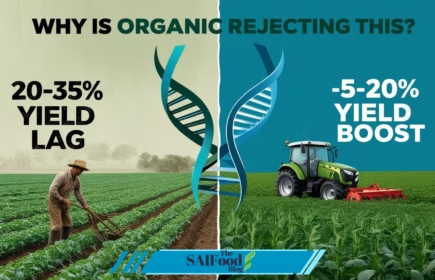A lack of sufficient nutrient application and the limited ability to control weeds, insects, and plant diseases, results in organic crop yields lagging behind conventional agriculture. The following statement may surprise you, but under optimal conditions, organic yields can be comparable with conventional agriculture. However, this is not often the case, as organic lags up to 70%, because achieving the necessary optimal conditions is a true challenge, for even the best producers.
When it comes to organic production and research, results vary from one crop and one study to the next. A 2012 comparison of 34 crop kinds found an organic yield lag of 26-33% for cereal crops and vegetables, while lettuce and related produce yields were similar to conventional. Another study which looked at organic production in the Netherlands found that yield lags declined over time, indicating a 13% lag between 2000 and 2013. An assessment of organic agriculture in the USA found a 20% lag based on production in 2014. Despite a growing interest in organic products, in France less land is being converted to organic production as in 2023, French organic farmers lost between 250-300 million euros (C$375-450 million). When it comes to meeting production marks, it isn’t easy being an organic producer.
Is Organic actually Subpar?
While there is no consensus on what organic yield lags are, the literature assessing this subject has some agreement that on average: yield lags range from 20-35% when all organic crops are assessed. Organic yields in a specific crop can be on par, although there is less evidence quantifying this. Comparable yields between conventional and organic are generally only for a specific crop in a very localized area.
Yield Increases from Gene Editing Technologies
When discussing conventional crop production, this can include that of biotechnological advancements, which include synthetic chemical or gene-edited crops. Gene editing technologies have been applied to crop variety development for over a decade now, resulting in higher-yielding varieties. While many of the yield increases that have been reported are based on field trials and the level will drop when scaled up to field production, the range of increases will still be significant when this occurs.
Scientists are discovering that silencing a single gene through precision mutagenesis can have significant yield increases. Research where a single gene was silenced in both rice and corn resulted in field trial yield increases of 8-10%. Multi-year and multi-field trial site Chinese research with soybeans found yield increases of 10-20%. A rice research collaboration involving American and Chinese researchers increased yields by 25-31%. Early field trials involving gene-edited potatoes found 50% yield increases. Australian wheat research involving gene editing technologies has created varieties with yields that are 10% higher.
These examples are but a few of the vast applications of gene editing technologies to increase the yields of all consumable crop kinds. Once these higher-yielding varieties are grown in large field production, the field trial yield increases will be slightly reduced, but yield increases from gene editing technologies could easily range from 5-20%, depending on the crop kind. The examples above also do not take into consideration the yield benefits when paired with improved chemical use, disease resistance, drought tolerance or any other important production factor.
Organic Industry Rejection of Yield-Enhancing Technologies
While conventional agriculture and farmers have embraced innovative crop breeding technologies of precision, organic farmers have not been willing to adopt these technologies. Crops have been routinely developed by the application of random, untargeted mutagenesis technologies dating back nearly 100 years. These new crop varieties are then adopted by organic farmers and grown within organic production requirements. However, while random, untargeted mutagenic technologies are acceptable, targeted, controlled mutagenic technologies, like gene editing are not. Gene editing technologies that are targeted and controlled are simply an evolution from random, untargeted mutagenic technologies.
In the USA, organic standards were revised in 2019 to specifically ban the use of crop varieties developed by gene editing. Organic organizations in the European Union and the United Kingdom have all expressed the same perspective: crop varieties developed by gene editing technologies would be banned from being eligible for organic production.
The Further Decline in Organic Production
By politically denying themselves access to cutting-edge crop variety development technologies, the organic sector is jeopardizing its future. News stories document that farmers are growing increasingly frustrated with the political aspects of organic production and are abandoning organic production in favour of GM crops. While no farming is easy, when your yields are lower in organic, it makes it that much harder to reach the level of success and profit needed to continue. Knowing this, conventional production is expected to increase as plant breeders utilize gene editing technologies to a greater extent in the development of new crop varieties.
But what will this all mean for organic? The rejection of new mutagenic breeding technologies will mean that the organic industry will continue to rely on old, outdated varieties with lower yields, lower disease tolerance, and lower drought tolerance. The reduction in yields will lower the profitability of organic production, which in turn will result in farmers reducing organic crop production. If yields of organic do not grow, and producers continue to decline and move to conventional farming practices, to survive organic producers need to further cut their costs of production, but it is more likely that instead, organic prices will have to rise to keep producers producing.


